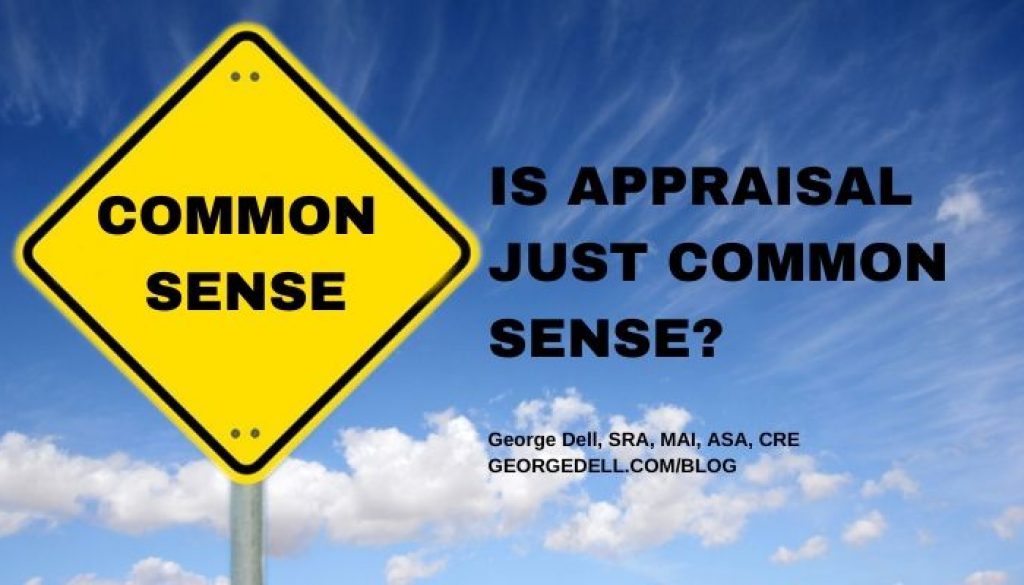What is common sense? How well does it work? Who has common sense? Who doesn’t?
This should be easy. Common sense is common. And it must make sense. It means every one should have it. Sense means perception: sight, hearing, touch. Sense can also mean a feeling about something; a realistic attitude about things; or, the way something can clearly be understood.
In the world of psychology, common sense is when most people would agree something is true, and the opposite therefore must be false. Common sense is often used as an argument for what should be “obvious” to any one with brains . . . Should be obvious.
So, it appears we have two basic meanings, depending on the objective of the speaker. One is “seeing how things really are and should be.” The second means no real reflection, analysis, or specialized training is needed. It just is true – obviously.
Appraisal work-scope, done properly, means you do what your peers would do in the same situation. That makes sense. Majority rule. Enforced by what users expect and enforcers enforce. A nice, clean box of common sense. So, what’s the problem?
The problem tends to arise when someone – a lawmaker, regulator, or other authority declares a new way things ‘should’ be done. And applies common sense – instead of reflection, analysis, and specialized training. Two examples:
- The residential 1004MC form, which claims “to provide the lender/client with a clear and accurate understanding of the market trends and conditions prevalent in the subject neighborhood”. This form answers the wrong question (the neighborhood trend rather than competitive market sales trend). And it gives the wrong answer, both in amount and direction of the relevant trend. (The problem is ignorance of statistical “information loss” which comes from grouping data). The 1004MC method seemed to be common sense. Unfortunately . . . .
- “Advanced” quantitative methods. These are taught and required for advanced designations. These were a response to a push for more sophistication in regression and ‘statistical’ methods. The authors did not know the purpose of inferential statistics: to portray a population from a random sample. Appraisal is substantially predictive in nature, in that the analyst’s job is to estimate or predict a value from a data set. Even the ASA (American Statistical Society) has made an official statement against this gross misuse of ‘statistics.’ Using sophisticated statistics seemed to be common sense. Unfortunately . . . .
In both cases, common sense is claimed, replacing a lack of basic data analysis principles. The result has been intentional and unintentional misuse of basic assumptions and applications of data analysis. Real reflection, analysis, or specialized knowledge is replaced by common sense. And accepted by all because the source was authoritative, rather than the result of critical thinking, research, and a touch of the needed skepticism.
These fundamental fallacies threaten collateral, investment, equity, and utility valuations. “Common sense” threatens repeated repetition of economic dysfunction. Consumers and investors lose their liberty and the pursuit of happiness. Common sense.

December 18, 2019 @ 7:29 am
Common sense dictates that a common definition be used. https://www.merriam-webster.com/dictionary/common%20sense
December 18, 2019 @ 9:40 am
Appraisal is defined/encompassed by regulatory agency definitions and requirements AND the imposed lender/user parameters, guidelines, restrictions and conveyance format. There is likely no common sense apparent to an uninitiated onlooker. Within the game, within all the boundaries above, there are what could be referred to as “obvious” decisions and conclusions throughout the process of developing an appraisal, so within the context/cloud/space (insert your own buzzword) it could be argued it would be “common sense” then to (thus and so, if-then etc)… in every endeavor, there is a period where the “apprentice” acquires the “common sense” to function at even a minimal level- any field, any craft, any science.